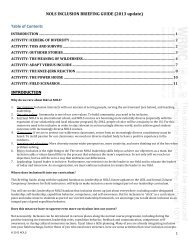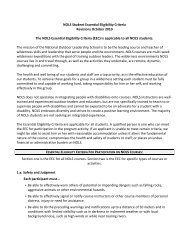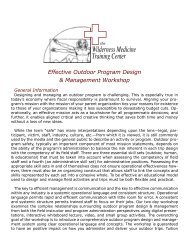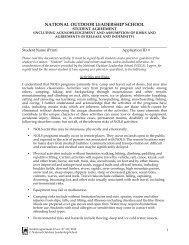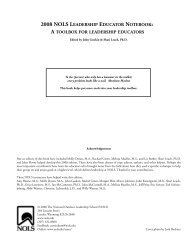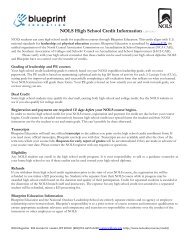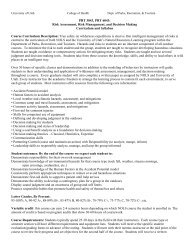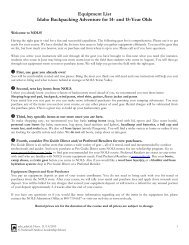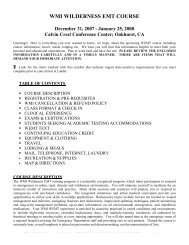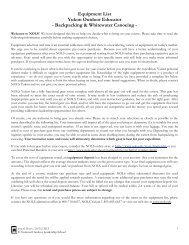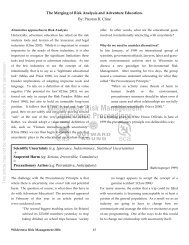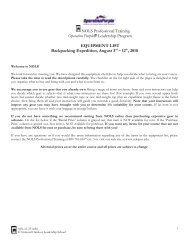Chapter Four: Decision Making and Judgement - NOLS
Chapter Four: Decision Making and Judgement - NOLS
Chapter Four: Decision Making and Judgement - NOLS
Create successful ePaper yourself
Turn your PDF publications into a flip-book with our unique Google optimized e-Paper software.
<strong>Chapter</strong> <strong>Four</strong>: <strong>Decision</strong> <strong>Making</strong> <strong>and</strong> <strong>Judgement</strong><br />
“Judgment in my estimation is the greatest safety factor you can<br />
have. Not only while the students are taking your course but for<br />
their safety after they leave your school <strong>and</strong> might do some of these<br />
things on their own.”<br />
Paul Petzoldt i<br />
Among the many competencies outdoor leaders need, perhaps<br />
the most important is the ability to make good decisions.<br />
Effective decision making, by both leaders <strong>and</strong> participants, is<br />
a cornerstone of adventure program risk management.<br />
Outdoor leaders make decisions all the time. The types of decisions<br />
you make can be loosely categorized as: 1) simple decisions,<br />
such as when to hold a class or a meeting; 2) decisions<br />
in response to an obvious hazard, like canceling a peak ascent<br />
because it’s snowing; <strong>and</strong> 3) decisions made when the danger<br />
is uncertain, such as deciding whether or not to launch boats<br />
in variable weather.<br />
Simple decisions are made frequently with little or no consequence.<br />
<strong>Decision</strong>s in the second category, when risk is obvious,<br />
tend to be infrequent but easy to make. <strong>Decision</strong>s in the third<br />
category, when danger is possible but not certain, are the most<br />
difficult to make; good responses rely heavily on sound judgment.<br />
The ability to make good decisions is based on how completely<br />
<strong>and</strong> accurately you identify <strong>and</strong> evaluate a situation. In the<br />
previous chapter on behaviors <strong>and</strong> attitudes, we mentioned<br />
awareness <strong>and</strong> watchfulness as two good habits to foster; they<br />
help you identify <strong>and</strong> evaluate situations. But it does you no<br />
good if you collect information about your situation — dark<br />
clouds moving quickly, wind picking up — <strong>and</strong> then misinterpret<br />
the signs — we can paddle across that lake. It is possible<br />
to collect information thoroughly but selectively ignore or misinterpret<br />
it. It’s also possible to be less than thorough in gathering<br />
data to help with a decision, yet still make a good decision.<br />
Good decisions are also rooted in your risk perception. In the<br />
previous chapter, we described how a situation that is voluntary,<br />
familiar, pleasant or predictable is perceived as less risky,<br />
while a new, dramatic, catastrophic, or difficult situation is<br />
perceived as riskier. <strong>NOLS</strong> instructor Ian McCammon has<br />
studied how outdoor leaders make decisions. He says, “One<br />
thing is certain: the way people make decisions in the face of a<br />
hazard has as much to do with their perceptions of the risk as<br />
it does with numerical probabilities.” ii<br />
In other words, one’s perception of a risk influences — correctly<br />
or incorrectly — his or her ability to assess risk. If you over<br />
or underestimate a threat, you increase the likelihood of making<br />
the wrong decision.<br />
<strong>Making</strong> good decisions, which is at the core of sound outdoor<br />
risk management, is based on the most complex human factors.<br />
Being able to recognize local weather patterns is an<br />
important skill. But being able to make decisions in relation to<br />
the weather patterns is more important — <strong>and</strong> more complicated.<br />
<strong>Decision</strong> making, judgment, risk perceptions <strong>and</strong> other<br />
human factors are all very closely linked. This chapter digs<br />
deeper into the complexities of decision making <strong>and</strong> judgment<br />
in risk management.<br />
How Teams Make <strong>Decision</strong>s<br />
Effective teams use an assortment of decision-making styles.<br />
The leader can make the decision or delegate it to the group.<br />
The leader can consult with the team, put the question to a<br />
vote or try to find consensus. Effective teams choose a decision-making<br />
process that is appropriate for the situation, their<br />
group, their leader <strong>and</strong> their group culture.<br />
You may want to choose a decision-making process that is suitable<br />
to how urgent the situation is <strong>and</strong> how capable your group<br />
is. If the circumstances are urgent (snow is falling) or the group<br />
is inexperienced at decision making (high school students), the<br />
leader decides the course of action. If there is more time to make<br />
the decision, <strong>and</strong> the group is capable <strong>and</strong> willing, then the<br />
leader can delegate more of the decision process to the group.<br />
Here are some decision-making choices:<br />
• Directive: The leader decides <strong>and</strong> informs the group.<br />
• Consultative: The leader solicits group input before making<br />
a final decision himself. The input from the group may be<br />
to comment on a decision recommended by the leader, or it<br />
may be input without knowledge of the leader’s preference.<br />
In either case, the decision is made by the leader.<br />
• Vote: The group decides by voting. Before the vote, make it<br />
clear if the decision will be by simple majority, two-thirds<br />
majority or another tally method. If the leader has any qualifications<br />
for the group decision, such as a right to veto if safety<br />
is compromised, these parameters should be made clear to<br />
the group beforeh<strong>and</strong>.<br />
• Consensus: The group makes a decision without voting. A<br />
clear definition of consensus – typically defined as a decision<br />
everyone can implement <strong>and</strong> support — should be<br />
agreed on beforeh<strong>and</strong>.<br />
• Delegate: The leader allows the group or an individual to make<br />
the decision, often within limits such as safety requirements.<br />
Risk Management for Outdoor Leaders A Practical Guide for Managing Risk Through Leadership 25
26<br />
LEVEL OF GROUP INVOLVEMENT<br />
DIRECTIVE<br />
CONSULTATIVE:<br />
Almost decide,<br />
then get input<br />
CONSULTATIVE:<br />
Get input,<br />
then decide<br />
VOTE<br />
LEVEL OF GROUP OWNERSHIP & URGENCY TO MAKE DECISION<br />
Every leader has a preferred process. Each process has strengths<br />
<strong>and</strong> weaknesses, <strong>and</strong> needs to be used fittingly. Regardless of<br />
the style chosen, you <strong>and</strong> your group should be clear on how a<br />
decision is being made, who is making it, <strong>and</strong> what will be the<br />
fallback if a decision isn’t reached.<br />
Consensus<br />
There is a myth that consensus is time consuming <strong>and</strong> leads<br />
to watered-down decisions where everyone compromises. A<br />
sea-kayaking group developed a travel plan using consensus<br />
for several key decisions. The leader-of-the-day sketched an<br />
overall vision <strong>and</strong> plan, then carefully listened to observations,<br />
questions <strong>and</strong> suggestions. As the plan evolved, the<br />
group made decisions <strong>and</strong> checked with each participant. If<br />
someone was uncomfortable, they actively sought a different<br />
approach until the concern was addressed. Ultimately, they<br />
devised a travel plan everyone embraced. This process was<br />
especially interesting because it challenged stereotypes of<br />
this group: the people involved were military fighter pilots.<br />
Outdoor or adventure education is a form of “experiential”<br />
learning. One of the fundamental elements of experiential education<br />
is that it is student-centered. The students or participants<br />
help direct their own learning. Naturally, students are then<br />
involved (to varying degrees) in course decisions. So participants<br />
too need to learn to be comfortable with various decision-making<br />
processes. By practicing different decision-making styles,<br />
you can challenge yourself <strong>and</strong> your group to step outside the<br />
CONSENSUS<br />
DELEGATE<br />
DECISION<br />
box. This creates a team that is adept at different styles. If a decision<br />
is not urgent, <strong>and</strong> you tend to be directive or consultative, try<br />
consensus or voting. If you’re normally passive, try participating<br />
in a medical scenario or emergency drill <strong>and</strong> be directive.<br />
How People Make <strong>Decision</strong>s<br />
When groups make decision, we’ve shown that there are a variety<br />
of processes to choose from. When individuals make decisions,<br />
they also have a variety of methods before them. Humans have<br />
developed fascinating <strong>and</strong> complex ways reach decisions. Over<br />
the past 30 years, there has been extensive research into human<br />
judgment <strong>and</strong> decision making. When coupled with new<br />
research on how the human brain works, light is being shed on<br />
our mysterious methods of decision making.<br />
“Rules of Thumb”or Heuristics<br />
One of the most common ways to make decisions is to rely on<br />
simple “rules of thumb,” also known as heuristics. Heuristics<br />
are problem-solving aids that you adopt from your experience.<br />
You use heuristics in everyday decisions, often without thinking.<br />
You come to some heuristics because they’ve been proven over<br />
time — measure twice, cut once. Others are supported by statistics<br />
— the advice that small samples do not accurately represent<br />
general populations.<br />
There are two types of heuristics: “domain heuristics” <strong>and</strong><br />
“generalized heuristics.” Domain heuristics are learned rules<br />
that work for specific activities like carpentry, climbing or skiing.<br />
Domain heuristics can be taught, such as bending your<br />
knees slightly <strong>and</strong> holding your poles up in front of you while<br />
skiing downhill. In science, Occam’s razor is a domain heuristic<br />
that advises choosing the simplest hypothesis that explains a set
<strong>Chapter</strong> <strong>Four</strong>: <strong>Decision</strong> <strong>Making</strong> <strong>and</strong> <strong>Judgement</strong><br />
of observations. Sutton’s Law is another that recommends trying<br />
a common explanation first to clarify something before resorting<br />
to an uncommon one. (Sutton was a bank robber who explained<br />
that he robbed banks because “that’s where the money is.”)<br />
Sometimes domain heuristics are remembered by a pneumonic<br />
like SERENE. This heuristic is used when evaluating a rock<br />
climbing anchor. SERENE st<strong>and</strong>s for Solid <strong>and</strong> Simple,<br />
Equalized, REdundant <strong>and</strong> Non-Extending — all elements of<br />
a good anchor.<br />
Seven Heuristics for Avoiding Avalanche Hazard<br />
1. Avoid steep slopes when the forecast hazard is high.<br />
2. Avoid terrain traps.<br />
3. Avoid obvious avalanche paths.<br />
4. Avoid steep slopes during periods of natural avalanching.<br />
5. Avoid steep slopes if you hear collapsing or whumphing.<br />
6. Avoid recently wind-loaded slopes.<br />
7. Avoid steep slopes during periods of sudden warming.<br />
Adapted from McCammon. Teaching <strong>Decision</strong> <strong>Making</strong> in<br />
Avalanche Terrain. <strong>NOLS</strong> Newsletter. December 2000.<br />
Someone who responds to a call of “rock” by immediately<br />
dropping into a defensive tuck position without knowing<br />
whether rocks are sliding, or someone who automatically<br />
brakes a rope when a climber calls “falling” without seeing the<br />
climber actually fall, are employing domain heuristics.<br />
Generalized heuristics are learned from your own experience<br />
<strong>and</strong> are based on recognizing patterns. For example, having<br />
information “just pop into your head” <strong>and</strong> believing that<br />
because you did this before it was the correct choice are general<br />
heuristics.<br />
Extrapolation, or the use of known facts to draw inferences about<br />
an unknown, is a heuristic. Medicine often relies on this —<br />
assuming that because a medication reduced symptoms in a set<br />
of patients, it will do so in others <strong>and</strong> save lives. Outdoor leaders<br />
extrapolate on weather trends all the time when making decisions.<br />
Heuristic decisions are not always accurate, but they’re right<br />
most of the time so we come to rely on them to make quick<br />
decisions. iii They can be effective for many decisions.<br />
Typically, heuristics are used at the threshold of our consciousness,<br />
<strong>and</strong> there is little time spent weighing alternatives or<br />
facts. As with any decision method, heuristics have pitfalls.<br />
They may not lead to the right outcome for the situation at<br />
h<strong>and</strong>, or you may misinterpret a sign that triggers the heuristic<br />
decision. These flaws are discussed in more detail later.<br />
Risk Management for Outdoor Leaders A Practical Guide for Managing Risk Through Leadership<br />
Fact, Myth or Educated Guess?<br />
Finding the information we need to make a decision is not<br />
easy. There are facts we cull from science. But these facts<br />
can be elusive when trying to predict natural phenomena like<br />
weather, avalanches or illness.<br />
There are things we think we know but they are really only<br />
based on good, not great science, logic that is sound but not<br />
solid, or experience with little depth. Our “facts” really may<br />
be educated guesses.<br />
At the bottom of the pile of information we draw from is urban<br />
legend, folklore <strong>and</strong> myth — often masquerading as fact. To<br />
protect against mistaking folklore for fact, you should develop<br />
a bit of skepticism, a habit of questioning assumptions.<br />
Don’t be a cynic. Skeptics question; cynics distrust.<br />
An example of this is our practice of disinfecting wilderness<br />
water. The biased warnings of the water-filter manufacturers<br />
<strong>and</strong> the dramatic statements on trailhead kiosks give the<br />
impression that the protozoa Giardia <strong>and</strong> Cryptosporidium<br />
are prevalent in the water <strong>and</strong> that illness is common.<br />
Outdoor texts <strong>and</strong> wilderness medicine courses repeat this<br />
advice. However, the facts are elusive.<br />
The few biological studies on wilderness water give us<br />
mixed results. Some argue contamination is prevalent, others<br />
that it’s uncommon. We can’t separate illness from poor<br />
camp hygiene with illness from drinking untreated water.<br />
There is good science that our methods for disinfecting<br />
water, boiling, chemically treating or filtering, have a low<br />
risk of making us sick.<br />
There is folklore that clear, fast moving alpine water is clean,<br />
that protozoa sink <strong>and</strong> thus surface water is safer to drink, or<br />
conversely, that protozoa float <strong>and</strong> are disinfected by ultraviolet<br />
radiation.<br />
We need to identify <strong>and</strong> discard the unclear scientific evidence<br />
on the risk of becoming ill from drinking untreated<br />
wilderness water <strong>and</strong> balance this with the consequences of<br />
not disinfecting our water, a nasty case of diarrhea. We take<br />
some sound but inconclusive science, mull the risk of<br />
becoming ill from how we disinfect water, <strong>and</strong> come up<br />
with a practice of habitually disinfecting water that is more<br />
than folklore, but less than clear science-based advice, it’s<br />
our best educated guess.<br />
27
Expertise<br />
Beyond heuristics, outdoor leaders — as well as pilots, physicians,<br />
paramedics, firefighters <strong>and</strong> other professionals — rely<br />
on expertise to make decisions. Research shows that experts<br />
forced to make decisions in difficult situations without much<br />
information turn to experience to arrive at a course of action.<br />
Gary Klein, author of “How People Make <strong>Decision</strong>s,” has<br />
developed a recognition-primed model, which describes this<br />
form of decision making. iv<br />
Research suggests that when a leader comes to a decision with<br />
relative ease his brain has recognized specific patterns, finds<br />
clues within those patterns, <strong>and</strong> then quickly comes to a decision<br />
by sorting through the clues. He can intuitively recognize<br />
a situation <strong>and</strong> evaluate his choices, accepting or rejecting<br />
them without lengthy side-by-side comparisons.<br />
The breadth of our experience therefore comes into play. An<br />
experienced medic can look at a patient’s appearance, see subtle<br />
clues, <strong>and</strong> come up with a hunch as to what is wrong —“This<br />
guy is having a heart attack!” An experienced rescuer can look<br />
at a map, terrain, a patient <strong>and</strong> the rescue team <strong>and</strong> know<br />
whether a litter-carry will be over shortly or take all night.<br />
Using our experience <strong>and</strong> proficiency to make decisions can be<br />
expeditious. The decision happens quickly, <strong>and</strong> we move on,<br />
perhaps not even realizing we made it. But this can leave us<br />
vulnerable to errors, <strong>and</strong> leave the novice quickly behind. If<br />
you’re helping your team learn to make decisions, stop <strong>and</strong><br />
explain what you have decided <strong>and</strong> how you came to the decision<br />
(assuming, of course, you have the time to do so). As with<br />
heuristics, there are pitfalls or traps with expert decision-making.<br />
These are detailed below.<br />
Analytical <strong>Decision</strong> <strong>Making</strong><br />
The more we learn about how people think <strong>and</strong> how the<br />
human brain works, the more we realize that people tend to<br />
make decisions with unscientific methods. We recognize patterns,<br />
use mental shortcuts like heuristics <strong>and</strong> other subconscious<br />
thought processes far more commonly than an analytical<br />
process. An analytical decision-making process appears<br />
complex <strong>and</strong> laborious — the tool of the Star Trek character<br />
Spock, the logical Vulcan, not the human Captain Kirk. The<br />
flow <strong>and</strong> spontaneity of heuristics or intuitive expertise to<br />
manage time-sensitive situations might be more appealing.<br />
However, many decisions in the wilderness are less urgent, <strong>and</strong><br />
you have the time for an analytical approach.<br />
If you are teaching novices how to make decisions, you need to<br />
consider that their experience may be low. They haven’t developed<br />
heuristics yet <strong>and</strong> need guidance in their decisions. At<br />
the same time, an experienced leader may find herself with an<br />
unusual or especially difficult problem. In this case a systematic<br />
approach of gathering information, weighing alternatives<br />
28<br />
<strong>and</strong> deciding what is best can be a valuable tool. An analytical<br />
approach can be thorough <strong>and</strong> well reasoned. It can help you<br />
organize <strong>and</strong> survey factors that will go into the decision.<br />
Here are some approaches to making an analytical decision:<br />
1. Describe the decision that needs to be made, or the problem<br />
that needs to be solved.<br />
Keep it simple. Try to say it from as many viewpoints as possible.<br />
This can illuminate the problem <strong>and</strong> point the way to<br />
alternative decisions.<br />
2. Identify parameters for the decision.<br />
Are there clear boundaries on this decision such as limits to your<br />
resources or route options. For example, there are no helicopters<br />
available for an evacuation, or there is a river you cannot cross.<br />
Consider guidance from your expedition’s mission <strong>and</strong> goals.<br />
<strong>NOLS</strong> has three field priorities which guide our decisions: safety<br />
of the person, care of the environment, care of the equipment.<br />
3. Gather information.<br />
Environmental:<br />
• What are the hazards?<br />
• Can they be avoided?<br />
• If not, can exposure be mitigated?<br />
Human:<br />
• Do we have the experience to make this decision?<br />
• Is the group fresh or fatigued, strong or weak?<br />
• Do we have the people <strong>and</strong> skills to manage the problem?<br />
• What is driving us to make the decision? Hidden agendas?<br />
Haste? Schedule?<br />
Resources:<br />
• What information do we need?<br />
• What gear do we need?<br />
Time:<br />
• Do we have time to make this decision? What is the urgency<br />
for this decision?<br />
4. Identify options or choices.<br />
• Are there alternatives?<br />
5. Compare the options. What are the consequences?<br />
• What could go wrong? Imagine alternative scenarios, solutions<br />
<strong>and</strong> outcomes?<br />
6. Decide, implement <strong>and</strong> evaluate<br />
• What style will you use for your decision: delegate, consensus,<br />
vote, or the leader decides?<br />
• Once you implement a decision, gain more information <strong>and</strong><br />
consider new options.
<strong>Chapter</strong> <strong>Four</strong>: <strong>Decision</strong> <strong>Making</strong> <strong>and</strong> <strong>Judgement</strong><br />
An analytical process works well when the situation can be supported<br />
by research, as in figuring out whether you have enough<br />
stove fuel to make it to the end of the trip or determining if a<br />
travel plan is reasonable if you leave at 6:00 a.m. These decisions<br />
are a matter of correct formulas, data <strong>and</strong> calculations. v<br />
While sound analytical processes can reveal more options, poor<br />
analytical skills can leave you vulnerable to a number of traps.<br />
A common trap is failing to notice the biases you bring to your<br />
analysis. Tendencies, developed over time from experience, are<br />
a lens thorough which we view every problem. While they can<br />
be powerful assets in thinking, they can also keep our minds<br />
closed to new information <strong>and</strong> alternative solutions. Morgan<br />
Jones, in the Thinker’s Toolkit vi , calls these tendencies “mindsets.”<br />
We detail how to avoid this pitfall below.<br />
Analytical processes only work well if we collect data <strong>and</strong> ponder<br />
alternatives well before making a decision. In <strong>Chapter</strong> 1<br />
on planning <strong>and</strong> preparations, we spoke of “what if” plans. In<br />
<strong>Chapter</strong> 3, we emphasized the importance of watchfulness,<br />
among other human factors. These habits can also help you<br />
• Waves<br />
Height<br />
Length <strong>and</strong>/or period<br />
Period or sets/lulls<br />
Steepness<br />
Breaking<br />
Trends<br />
• Tides<br />
• Currents<br />
• Sea state<br />
• Water temp<br />
RED light = STOP, a hazardous<br />
situation exists.<br />
YELLOW light = CAUTION, there is a<br />
potential hazard, too much uncertainty,<br />
or conditions are deteriorating.<br />
GREEN light = It is OK, no hazard<br />
is obvious.<br />
Sea Conditions<br />
Seamanship<br />
Human<br />
Factors<br />
Risk Management for Outdoor Leaders A Practical Guide for Managing Risk Through Leadership<br />
make sound decisions. An astute outdoor leader is always<br />
gathering data: Who are the strong group members? Who are<br />
the weak ones? Who has been injured or ill? Are they recovering?<br />
What are the weather patterns? Is the expedition ahead of,<br />
behind or on schedule? What are the upcoming risks — a river<br />
crossing, exposed coastline, high pass, summit attempt?<br />
Continually gathering this data over time can speed up the<br />
analysis when it’s time to make a decision.<br />
Situational awareness, as we discussed in the previous chapter,<br />
provides a means for keeping tabs on the factor we may need<br />
when making a decision. Here is the <strong>NOLS</strong> Seamanship<br />
Triangle again, but with more information about the variables<br />
<strong>and</strong> some guidance for making a decision. The use of red, yellow<br />
or green to denote the seriousness of conditions or terrain<br />
may seem simplistic, but it can be effective. If after weighing<br />
the objective <strong>and</strong> subjective factors of a situation, the leader or<br />
the group determines the conditions are red, then the decision<br />
is to stop. If the conditions are determined to be green, they go<br />
forward. And if conditions are yellow, they may go forward but<br />
with special attention to risk.<br />
• Experience<br />
Paddling experience in these conditions<br />
Recovery practive in these conditions<br />
• Skills<br />
Comfort in these conditions<br />
Boat control, power <strong>and</strong> bracing competency<br />
• Communication<br />
Level of honesty, listening <strong>and</strong> mutual<br />
respect<br />
• Attitude<br />
Schedule, pressures <strong>and</strong> goals<br />
• Physical Strength, health <strong>and</strong> wellness<br />
• Equipment<br />
Boat design, condition <strong>and</strong> safety gear<br />
Terrain Conditions<br />
• Pull-outs<br />
S<strong>and</strong> or rock<br />
Steepness<br />
Exposure<br />
• Commitment<br />
Cliffs<br />
Points<br />
Crossings<br />
Weather Conditions<br />
• Hazards<br />
Shoals <strong>and</strong> bottom features<br />
Reefs, rocks <strong>and</strong> boomers<br />
Boat traffic<br />
Ice<br />
• Protection from wind <strong>and</strong><br />
weather<br />
• Remoteness<br />
• Wind<br />
Direction<br />
Speed/force<br />
Fetch<br />
Duration<br />
• Precipitation or fog<br />
• Cloud<br />
Type<br />
Progression<br />
• Local patterns<br />
• Barometer changes<br />
• Air temp<br />
• Weather report<br />
29
R<strong>and</strong>om Choice<br />
It may be surprising, but r<strong>and</strong>om choice is not necessarily an<br />
abdication of decision-making. There are times when it is the<br />
wise choice. If you don’t have the experience, information or<br />
expertise to decide between alternatives, <strong>and</strong> if the consequences<br />
are not serious, then taking a guess rather than wasting<br />
time on deliberation may be a good choice. According to<br />
<strong>NOLS</strong>’ Ian McCammon, the added bonus is simply calling the<br />
process what it is <strong>and</strong> getting away from the expectation that a<br />
formal process must underlay all decisions. You’ll also learn<br />
that sometimes action, which gives you experience <strong>and</strong> information,<br />
is better than endless discussion. vii<br />
The decision-making methods we’ve detailed are not listed in<br />
a hierarchy from simple to complex or novice to expert, but are<br />
a menu of choices. We have used all of these decision-making<br />
tactics, sometimes consciously, sometimes unconsciously.<br />
Sometimes our decision is a r<strong>and</strong>om choice; sometimes it’s<br />
based on a rule-of-thumb, an expert pattern of recognition or<br />
an analytical process. As with group decision-making processes,<br />
each of these has strengths <strong>and</strong> weaknesses. If we are aware<br />
of the process we are using, we might be able to decide if it’s<br />
the most appropriate for this particular situation — <strong>and</strong> we<br />
might become more aware of the hazards that lie within each<br />
method.<br />
Hazards in <strong>Decision</strong> <strong>Making</strong><br />
There is risk in everything we do, including making decisions.<br />
There are perils, sometimes called decision-traps, in every decision-making<br />
method that can lead us to make the wrong<br />
choice. But you can gain an awareness of these traps, <strong>and</strong> help<br />
avoid falling victim to them.<br />
Pitfalls in Individual <strong>Decision</strong>s<br />
After every decision, it is vital to receive feedback <strong>and</strong> take it<br />
to heart. It is possible to make a decision that achieves the<br />
intended outcome — yet in reality it was a poor decision with<br />
a lucky outcome. If someone never receives feedback that in<br />
fact the decision was poor, he won’t have a reason to change his<br />
judgment. For example, a group of hikers wading across a<br />
river chooses a spot with a strong current, thigh-deep water<br />
<strong>and</strong> a poor run out, rather than taking more time to search for<br />
a better spot. They make it across… this time. The positive<br />
outcome, getting across the river, may mislead the team into<br />
thinking they made a good decision. But next time, they may<br />
not be so lucky.<br />
Our memory is shaped by events associated with strong emotions.<br />
If something gives you great pleasure, you’ll want to do<br />
it again. The hikers in our example may feel a strong sense of<br />
accomplishment from “tackling” their formidable obstacle.<br />
But they would be unwise to believe they should do it again<br />
<strong>and</strong> again.<br />
30<br />
Heuristic Traps<br />
In his research, McCammon highlights six common heuristic<br />
(or rule-of-thumb) decision-making traps. A theme running<br />
throughout them is a heavy reliance on a heuristic despite contrary<br />
information.<br />
In the familiarity trap, we believe that familiar situations are<br />
safe or controllable, when they may need to be evaluated as a<br />
unique scenario. We have a tendency to fall into a pattern of<br />
making the same decision, despite evidence that this situation<br />
has changed. viii<br />
In the acceptance trap, we want to make a decision that others<br />
will like. It’s natural to want to be accepted by others, especially<br />
those whom we respect or want to impress. Peer pressure<br />
plays a role in this trap, <strong>and</strong> we may ignore or not recognize<br />
factors because we want the decision to be accepted.<br />
The consistency trap is a tendency to be consistent with an<br />
earlier decision. This can make for quicker decisions <strong>and</strong> can<br />
be effective, except if we overlook clues that could lead to a<br />
better decision.<br />
The trap of social proof trips us up when we assume that<br />
because others have done it, it must be acceptable. For example,<br />
we can be influenced by the lore that a particular route is<br />
safe. In reality, this route may have the same hazards as any<br />
other, <strong>and</strong> our good experience has just been good fortune <strong>and</strong><br />
not indicative of the normal pattern.<br />
Just as the brain fills in a visual blind spot in an image with the<br />
surrounding color <strong>and</strong> pattern to produce the illusion of a<br />
complete image, we have a predisposition to validate expectations<br />
about what correlates with what, <strong>and</strong> to see relationships<br />
that are not in the evidence. ix, x<br />
Newer can be assumed to be better. We’ve seen this recently<br />
with the second generation of non-steroidal anti-inflammatory<br />
drugs such as Vioxx – rushed to the market, widely<br />
embraced, then dramatically withdrawn as unwanted side<br />
effects became apparent. This newness effect is our tendency<br />
to give importance to recent information or events - days of<br />
beautiful weather instead of the normal afternoon thunderstorm.<br />
This is a subtle trap in the Rocky Mountains where<br />
periods of beautiful summer weather can lure a climber to<br />
linger too long on exposed peaks, making him vulnerable to<br />
afternoon thunderstorms which are a norm.<br />
Expertise Traps<br />
An overconfident expert can make a mistake when she tries to<br />
use her expertise where it doesn’t fit — trying to use pattern<br />
<strong>and</strong> clue recognition from one area to a completely new area.<br />
For example, an expert whitewater kayaker using her river paddling<br />
skills to perform a sea-kayak surf l<strong>and</strong>ing, even if she has
<strong>Chapter</strong> <strong>Four</strong>: <strong>Decision</strong> <strong>Making</strong> <strong>and</strong> <strong>Judgement</strong><br />
never sea kayaked before. Situations may be similar, but they<br />
may require different skills.<br />
A variation of this hazard is the expert halo trap or the expectation<br />
that someone knowledgeable in one area is able to make<br />
a decision in a new <strong>and</strong> different area. For example, the practiced<br />
outdoor leader may be assumed to have medical<br />
expertise despite limited first aid experience. Conversely, the<br />
hospital-based physician may be assumed to know how to<br />
manage a wilderness crisis, when in reality they are limited by<br />
the lack of equipment <strong>and</strong> the environment.<br />
Analytical Traps<br />
In addition to being time consuming, an inherent hazard in<br />
analytical decision-making is the challenge of identifying,<br />
comparing <strong>and</strong> evaluating all of the pertinent variables, especially<br />
if some are unknown (often the case in wilderness settings).<br />
For example, we may choose to go over a pass after<br />
careful <strong>and</strong> thorough review of the map, the weather <strong>and</strong> the<br />
group’s abilities, yet we really don’t know what the other side<br />
of the pass will be like until we get there.<br />
Pragmatically, we need to make decisions based on incomplete<br />
information. The necessary information may be inaccessible<br />
or lacking important details. In the medical field, for example,<br />
researchers tend to report only positive results, leaving critical<br />
gaps in our underst<strong>and</strong>ing of a problem.<br />
We are prone to accept too readily something based on wishful<br />
thinking. A recent example: the embracing of suction<br />
devices for snakebite treatment. The devices were developed<br />
from a theory that venom could be extracted from tissue before<br />
it caused damage. Many embraced the concept — <strong>and</strong> the<br />
devices — before research showed that removing venom, in<br />
fact, does not happen.<br />
An analysis is only as thorough <strong>and</strong> accurate as the information<br />
we choose to include, <strong>and</strong> the rigor with which we interpret it.<br />
The outcome may look like science but can be biased by our<br />
choices or a desired alternative. Many of us have made the mistake<br />
of ignoring what the terrain is telling us in favor of what<br />
we expected to see from a map.<br />
When using analytical decision making, consider adding a<br />
“humility factor” that takes into account that your information<br />
may be weak.<br />
One incident is not a trend<br />
The probability estimation or availability trap is a tendency<br />
to overestimate the probability of an event which is easily <strong>and</strong><br />
vividly imagined or to believe that one dramatic event represents<br />
a class of such events.<br />
John Ross, writing in the Polar Bear Strategy xi , notes how<br />
Risk Management for Outdoor Leaders A Practical Guide for Managing Risk Through Leadership<br />
experts assess risk with data while the public assesses risk<br />
through theories <strong>and</strong> assumptions. If someone sees something<br />
frequently because it is disproportionately visible (let’s say<br />
repeated television images of a kidnapping in a foreign country),<br />
they’ll assume it happens frequently when in fact it may<br />
be extremely uncommon. At the turn of the 20 th century,<br />
William Osler, a distinguished physician <strong>and</strong> medical educator,<br />
remarked, “We are ever beset with the common failing of<br />
reaching conclusions from superficial observations <strong>and</strong> misled<br />
when our minds fall into the ruts of one or two experiences.”<br />
This is a trap that outdoor program administrators should be<br />
aware of when the urge arises to create policy in response to a<br />
single dramatic event that is really an isolated incident.<br />
Outdoor leaders can fall into this trap too, for instance, if they<br />
see one or two cases of an illness <strong>and</strong> then assume it is widespread<br />
when in fact they saw only the isolated cases. The trap<br />
is correlation equaling causation — the tendency to perceive<br />
that two events are related when in fact their connection is<br />
coincidental or even non-existent. Falling prey to this illusory<br />
correlation can lead to suboptimal practices<br />
Pitfalls in Group <strong>Decision</strong>s<br />
Group decisions have hazards <strong>and</strong> “group-think traps” of their<br />
own, such as pressured agreement, risk polarization, support<br />
<strong>and</strong> attribution theory. Be aware that members of small groups<br />
affect each other more than members in larger groups. In a<br />
smaller group, a single member’s impact is direct <strong>and</strong> immediate.<br />
A smaller group’s decisions can be more impulsive.<br />
In larger groups it’s more difficult to voice a question or a contrary<br />
opinion, so the tendency is to agree with the group. xii<br />
Peer pressure can be a real problem in hasty decisions made by<br />
large groups.<br />
Peer pressure is also cited as a cause of risk polarization, which<br />
is an inclination for groups to take significantly more (or less)<br />
risks than individuals. In a big group, participants will compare<br />
their opinion to others, <strong>and</strong> be swayed by how they<br />
believe their group is thinking. It stems in part from a desire<br />
to be a good team member, <strong>and</strong> in part from believing that a<br />
majority’s ideas must be more correct than their own. xiii<br />
Attribution theory says groups make riskier decisions because<br />
the consequences of a decision are borne by the group, not an<br />
individual. xiv<br />
Support theory proposes that the probability of an event or<br />
the weight of evidence is inappropriately influenced by how<br />
detailed a particular description or discussion is. Greater detail<br />
can be misinterpreted as being more credible or accurate. In a<br />
similar vein, decisions can be influenced by the order in which<br />
things are discussed. Information presented later might be<br />
given more weight than information presented earlier.<br />
31
In the “information cascade model,” everyone starts with similar<br />
information, which then evolves over time. Some people<br />
may get good information, which they share with the group,<br />
or they may unwittingly get bad information, which is also<br />
shared. The group then makes a poor decision based on this<br />
misinformation. This isn’t a case of mindless following. It’s a<br />
case of people thinking they are getting good information,<br />
when in reality it’s poor information that is woven into a cascade<br />
of decisions. Instead of pooling <strong>and</strong> looking at all the<br />
information, the cascade becomes a sequence with a poor<br />
choice or poor information imbedded in the decision chain.<br />
How do you avoid the group-think trap? First, if you’ve carefully<br />
built a team that can speak up <strong>and</strong> question, you should<br />
have a tool to avoid group think. You need to be careful that<br />
the order of a discussion or the time spent on an individual<br />
point does not unduly influence the final decision. Consider<br />
having the leader or expert speak last. This lessens their influence<br />
on the contributions of earlier speakers.<br />
You need to be sensitive to the tone of your group <strong>and</strong> the subtle<br />
clues, such as body language, that alert you to individuals<br />
who are silent but not in agreement. Consider it a red flag if<br />
there are no dissenting or diverse opinions. You may have the<br />
illusion of correctness, while the group rationalizes away counterarguments,<br />
suppresses dissent <strong>and</strong> assumes consensus.<br />
Judgment<br />
Paul Petzoldt, the founder of <strong>NOLS</strong>, is also the father of outdoor-leadership<br />
education. Petzoldt’s advocacy for the use of<br />
judgment by outdoor leaders was passionate <strong>and</strong> infectious.<br />
His insistence on the importance of developing good judgment<br />
in leaders, combined with his charismatic personality <strong>and</strong> his<br />
ability to communicate <strong>and</strong> connect with young people, has<br />
had a profound influence on adventure education today.<br />
Good judgment is not choosing the perfect answer. It’s choosing<br />
a correct answer within the limits of your experience,<br />
knowledge <strong>and</strong> abilities. Judgment is not reserved for experts<br />
with years of experience. Novices can make thoughtful, sensible<br />
<strong>and</strong> prudent choices with simple practical wisdom —<br />
common sense.<br />
In the dictionary, judgment <strong>and</strong> decision making are essentially<br />
the same: a process of forming an assessment, analyzing <strong>and</strong><br />
comparing the information <strong>and</strong> options, <strong>and</strong> then laying down<br />
an opinion. xv In the adventure-education culture, we define a<br />
subtle but important difference. <strong>Decision</strong> making is more<br />
clear <strong>and</strong> straightforward than judgment. A situation calling<br />
for judgment can imply you don’t have all the information or<br />
the circumstances are complex, fluid <strong>and</strong> at the edge of your<br />
experience. It requires creative thought. In outdoor education,<br />
we place judgment on a higher plane than simple decisions.<br />
32<br />
Experience alone does not give us good judgment. And regardless<br />
of the off quoted “Judgment comes from experience <strong>and</strong><br />
experience comes from bad judgment,” you don’t need bad<br />
judgment to gain wisdom from experience. Judgment only<br />
comes after reflecting on the experience. It’s a never-ending<br />
cycle of experience, reflection, learning <strong>and</strong> prediction of subsequent<br />
experience, then reflection <strong>and</strong> the cycle starts anew. xvi<br />
Experience<br />
Learning & Prediction<br />
Adapted from Priest, 1988. xvii<br />
Reflection<br />
Educators can assist their students in developing judgment<br />
when they give context to the students’ experiences by explaining<br />
why <strong>and</strong> how decisions are made, suggesting alternatives to<br />
their decisions, probing how they came to a decision, <strong>and</strong> asking<br />
what factors they used. Through reflection, students <strong>and</strong><br />
leaders can continually refine their judgment. Mentors <strong>and</strong><br />
coaches, trusted counselors or guides are invaluable for this.<br />
Seek people who give honest feedback, <strong>and</strong> learn from them.<br />
There was a time in adventure education when instructors<br />
took pride in the fact that there were few guidelines, protocols<br />
or rules. They routinely made independent decisions. There<br />
was very little written information for leaders. Knowledge <strong>and</strong><br />
wisdom was communicated by word-of-mouth <strong>and</strong> experience.<br />
The famous Petzoldt quote, “Rules are for fools,” was,<br />
<strong>and</strong> still is, a slogan for adventure educators who value using<br />
their judgment over following a list of rules.<br />
In reality, Paul was not adverse to st<strong>and</strong>ard practices. When Paul<br />
coined “Rules are for fools,” his intent was along a heuristic<br />
approach, that is, rules are for inexperienced folks. He thought<br />
novices needed rules to support their decisions while they gain<br />
the experience to build their judgment. He knew a rules-based<br />
approach can be useful in conveying the expectations of the<br />
organization, adding consistency to programming, or compensating<br />
for a lack of staff training opportunities or resources.<br />
Petzoldt also said: “A leader with limited knowledge <strong>and</strong> superior<br />
judgment is better than one with vast knowledge <strong>and</strong> little<br />
judgment.” Today, there exists a cornucopia of information<br />
to feast upon — books (including this one), articles, journals,<br />
manuals, conferences, seminars <strong>and</strong> videos. But don’t confuse this<br />
wealth of information with judgment or experience. The complex<br />
decisions outdoor leaders have to make are difficult to capture in<br />
a book (believe us we’ve tried!) Despite the increase of information<br />
<strong>and</strong> know-how in adventure education, there is no parallel<br />
decline in the dem<strong>and</strong> for instructors with good judgment.
<strong>Chapter</strong> <strong>Four</strong>: <strong>Decision</strong> <strong>Making</strong> <strong>and</strong> <strong>Judgement</strong><br />
Storytelling<br />
Stories have a particularly powerful impact, especially<br />
when presented as dramas that ignite the moral imagination<br />
<strong>and</strong> invite us all to be drawn into the action. A good<br />
story will trump a good fact any day of the week. Many<br />
instructors have experienced the feeling of helplessness as<br />
their well researched facts <strong>and</strong> logical teaching progression<br />
crumple in the face of a student’s influential, but inaccurate<br />
story.<br />
What makes these stories so powerful? There are strong<br />
links between our emotional <strong>and</strong> cognitive centers in our<br />
brain. Our brains seem built to process stories better than<br />
other forms of input. It’s not just awful things that happened<br />
in these stories, it’s that they happened to the person<br />
telling the story, or a close friend, cousin, acquaintance.<br />
It has an empathetic hook.<br />
Stories are memorable, <strong>and</strong> trigger our bias towards what<br />
is easy to recall. They can frame evidence in a particular<br />
context that can be manipulated rhetorically by the teller.<br />
They can be especially powerful if they present things outside<br />
the control of the main character <strong>and</strong> generate sympathy<br />
for the victim.<br />
You can find a sense of what the culture values by listening<br />
to an epic tale told around the fire or the stove. Often<br />
these stories have heroic elements; overcoming weather,<br />
pioneering a new route, overcoming adversity, demonstrating<br />
strength <strong>and</strong> stamina. They often tell of a long <strong>and</strong><br />
strenuous outdoor trip that pushes people’s limits, or the<br />
natural event (rockfall, lightning, avalanche, flashflood)<br />
that places people at the edge of what they can control.<br />
They are memorable, sometimes frightening learning experiences<br />
that afterwards are glamorized in the epic tale. xviii<br />
We need to listen carefully to our stories. They can influence<br />
the novice who does not yet underst<strong>and</strong> that epics<br />
tend to award the bold rather than the prudent, the unprepared<br />
rather than the prepared. Vilhjalmur Stefansson,<br />
Canadian arctic explorer, said that ‘adventure was a sign of<br />
incompetence.’ xix Whenever someone came back telling a<br />
story of adventure, he was thinking that they screwed up.<br />
Risk Management for Outdoor Leaders A Practical Guide for Managing Risk Through Leadership<br />
There is a role for learning the lessons of history <strong>and</strong> for following<br />
st<strong>and</strong>ard practices <strong>and</strong> protocols. Ideally, our practices<br />
<strong>and</strong> protocols are the history of learning from those who came<br />
before us. They represent the accumulated good judgment of<br />
our peers.<br />
And there is a role for independent judgment <strong>and</strong> decision<br />
making in leadership. Life is too complex to be predicted in an<br />
operating procedure, accepted practice, policy, rule, guideline<br />
or textbook. Leaders need decision-making skills <strong>and</strong> the<br />
judgment to make good decisions when choices are unclear<br />
<strong>and</strong> the situation is unique. It’s crucial we nurture, celebrate<br />
<strong>and</strong> teach judgment. It promotes self-responsibility. It’s realistic<br />
<strong>and</strong> practical. It’s a gift we can give our students.<br />
Summary Points<br />
• The ability to make good decisions is a cornerstone of adventure<br />
program risk management.<br />
• Outdoor leaders make simple decisions of low consequence,<br />
decisions in response to clear hazards, <strong>and</strong> decisions when<br />
the danger is not clear, or present.<br />
• <strong>Decision</strong>-making, judgment, risk perceptions <strong>and</strong> other<br />
human factors are all very closely linked.<br />
• Teams use a variety of decision-making styles including<br />
directive, consultative, voting, consensus <strong>and</strong> delegating.<br />
• Individuals make decisions in a variety of ways as well, using<br />
heuristics, expertise or an analytical process.<br />
• Experts use observations, context <strong>and</strong> experience to arrive<br />
at a course of action. They recognize patterns <strong>and</strong> can<br />
quickly evaluate choices.<br />
• An analytical approach of gathering information, weighing<br />
alternatives <strong>and</strong> then deciding what is best can help you<br />
organize <strong>and</strong> survey factors in the decision.<br />
• Heuristics are simple rules-of-thumb, aids to problem solving<br />
that are used every day.<br />
• There are numerous traps that can lead to poor decisions.<br />
Among them are consistency, social proof, proximity traps,<br />
an appearance of objectivity, the influence of emotions, inaccurate<br />
probability assessments <strong>and</strong> group think errors.<br />
• Wise leaders know when to rely on st<strong>and</strong>ard practices <strong>and</strong><br />
protocols <strong>and</strong> when independent judgment <strong>and</strong> decisionmaking<br />
is needed.<br />
33
34<br />
<strong>Decision</strong>-<strong>Making</strong> Traps<br />
Familiarity Believing a familiar situation is safe or controllable <strong>and</strong> ignoring evidence that this situation is<br />
different.<br />
Acceptance A tendency to make a decision that others will like.<br />
Consistency <strong>Making</strong> choices consistent with an earlier decision, despite evidence suggesting a different<br />
choice might be better.<br />
Social proof Assuming that because others did it, it’s a good choice.<br />
Confirmatory bias Ignoring observations because they don’t fit a known pattern or desired result.<br />
Recency effect A tendency to give importance to recent information or events.<br />
Expert halo The expectation that someone knowledgeable in one situation can make a good decision in a new<br />
or different situation.<br />
Mind-set A decision that may look analytical but is biased by our personal choices or desired alternative.<br />
Unproven assumptions Accepting plausible but unproven information as the basis of a decision.<br />
Probability estimation A tendency to overestimate the likelihood of an event because it is dramatic.<br />
Illusory correlation Assuming an isolated event is representative of a pattern or class of events.<br />
Risk polarization A tendency for groups to become risk-prone or risk-adverse <strong>and</strong> then take significantly more or<br />
less risk than individuals would.<br />
Attribution Theory A tendency for groups to make riskier decisions than an individual.<br />
Support Theory Because of greater detail in a particular presentation, placing emphasis on that evidence <strong>and</strong><br />
allowing it to influence a decision.<br />
Information Cascade Bad information, imbedded in a thought process, influencing ideas without correction over time.
<strong>Chapter</strong> <strong>Four</strong>: <strong>Decision</strong> <strong>Making</strong> <strong>and</strong> <strong>Judgement</strong><br />
i Tape recording debriefing of COBS Course C-10 <strong>NOLS</strong><br />
Historical Archives. L<strong>and</strong>er, Wyoming.<br />
ii McCammon, I. Sex, Drugs <strong>and</strong> The White Death: Lessons<br />
For Avalanche Educators From Health <strong>and</strong> Safety Campaigns.<br />
Paper presented at the International Snow Science Workshop.<br />
Sept. 19–24, 2004, Jackson, Wyoming.<br />
iii Plous, S. The Psychology of Judgment <strong>and</strong> <strong>Decision</strong><br />
<strong>Making</strong>. New York McGraw-Hill, Inc. (1993)<br />
iv Klein G. Sources of Power: How People Make <strong>Decision</strong>s.<br />
MIT Press. 1998.<br />
v McCammon I. <strong>Decision</strong> <strong>Making</strong> for Wilderness leaders:<br />
Strategies, Traps And Teaching Methods. Syllabus of the<br />
Wilderness Risk Managers Conference. National Outdoor<br />
Leadership School. 2001.<br />
vi Jones, M. The Thinker’s toolkit. R<strong>and</strong>om House. New<br />
York. 1995.<br />
vii McCammon, I. <strong>Decision</strong>-making Strategies. <strong>NOLS</strong><br />
Leadership Educator Notebook. The National Outdoor<br />
Leadership School. 2004.<br />
viii Tversky A,.Kahneman D. The framing of decisions <strong>and</strong><br />
the psychology of choice. Science 1981;211:453-8<br />
ix Redelmeier D, Rozin P, Kahneman D. Underst<strong>and</strong>ing<br />
Patients’ <strong>Decision</strong>s: Cognitive <strong>and</strong> Emotional Perspectives.<br />
JAMA 1993;270:72-6.<br />
x Ramach<strong>and</strong>ran V. Blind Spots. Scientific American.<br />
1992;266:86-91.<br />
xi Ross J. The Polar Bear Strategy: Reflections on Risk in<br />
Modern Life, Perseus Books, Reading, MA 1999<br />
xii Janis, I.L. Groupthink: Psychological Studies of Policy<br />
<strong>Decision</strong>s <strong>and</strong> Fiascoes (2nd ed.). Boston: Houghton Mifflin.<br />
(1982).<br />
xiii Cass Sunstein. Why Societies Need Dissent. Harvard<br />
University press. September 2003. Oliver Wendell Holmes<br />
lectures.<br />
xiv Cartwright, D. Rick taking by Individuals <strong>and</strong> Groups.<br />
Journal of Social Psychology. Vol. 20 (1966).<br />
xv Reference Websters Collegiate.<br />
Risk Management for Outdoor Leaders A Practical Guide for Managing Risk Through Leadership<br />
xvi Adapted from Priest. S. (1988). The role of judgment,<br />
decision making <strong>and</strong> problem solving for outdoor leaders.<br />
Journal of Experiential education, 11(3), 19-26. (1988)<br />
xvii Priest, S. (1988). The role of judgment, decision making<br />
<strong>and</strong> problem solving for outdoor leaders. Journal of<br />
Experiential education, 11(3), 19-26. (1988)<br />
xviii Haddock C. Epics, Lies <strong>and</strong> Hero Stories: The folklore of<br />
near misses in the outdoors<br />
Proceedings Wilderness Risk Managers Conference. National<br />
Outdoor Leadership School. L<strong>and</strong>er, Wyoming. 1999.<br />
xix Hunt W, Stef: A Biography of Vilhjalmur Stefansson. Univ<br />
of British Columbia Press 1986.<br />
35
36<br />
Clear <strong>and</strong> concise instruction develops team competency <strong>and</strong> self-awareness: an instructor gives a class on top rope anchors.<br />
Tom Bol




